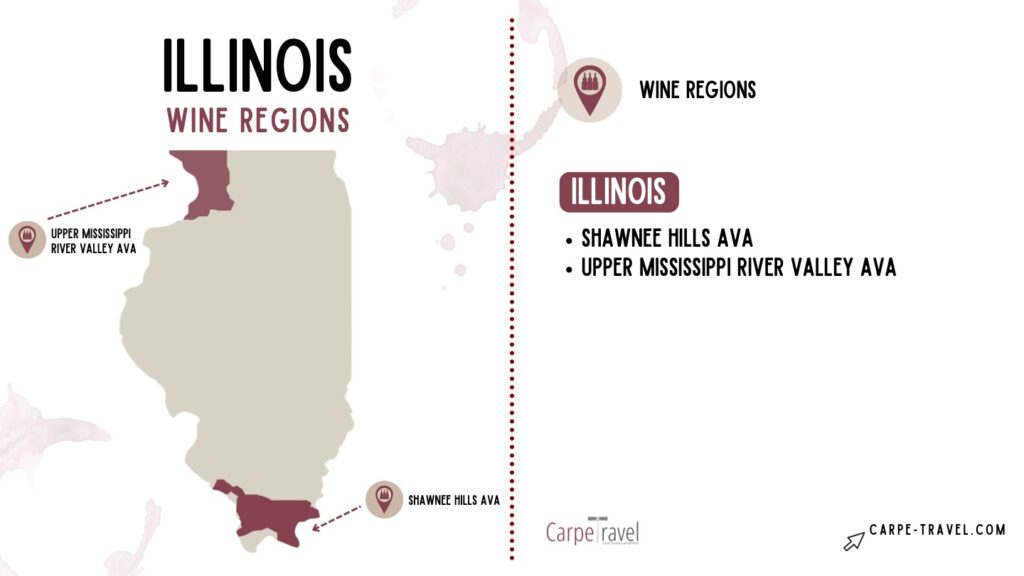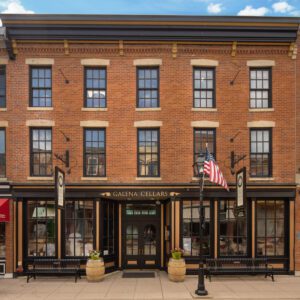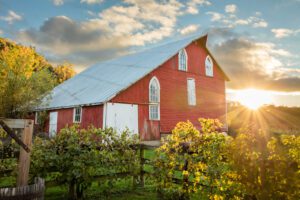Discover Illinois
Wine Country
Our Illinois Wine Travel Guide shares a brief history of the wine region, terroir, where to sip, where to stay and things to do beyond the vines.

WHERE IS ILLINOIS WINE COUNTRY?
When it comes to visiting Illinois wine country, the first step is to decide if you want a city or country experience. Illinois is a spacious state, and you can’t see it all in three days, or even three weeks. Carpe Travel suggests visiting the Northern Illinois Wine Trail in the Upper Mississippi River Valley AVA, starting in Galena then heading towards Chicago for an urban experience. Then heading to the southern tip of the state to visit the Shawnee Hills AVA for an authentic wine country immersive tour.
BEST TIMES TO VISIT
Spring and autumn are the most temperate and comfortable times to visit Illinois wine country. New vintage releases come out in the spring and summer, so there will be plenty of fresh wines to try. Autumn brings gorgeous colors and bustling harvests as winemakers rush to vinify the season’s grapes. Wineries are busy with business during harvest so spring and summer may be the best time to visit Illinois wine country.
GETTING THERE
TRAIN: Chicago has 11 Amtrak trainlines that service Chicago and its surrounding regions. The Illinois Service route ventures from Chicago to Carbondale and the Shawnee Hills AVA in th southern sector of the state. The California Zepher connects Chicago to Denver, Salt Lake, and San Francisco, and the Cardinal or Lake Shore Limited connect Chicago to the east coast. Most routes offer dining, wifi, checked and carry-on baggage, and flexible rescheduling. Small pets ride for free. The St. Louis MetroLink light rail connects the Mid-America St. Louis Airport with Belleville, Illinois.
FLY: For easy access to the Northern Illinois Wine Trail, fly into Chicago International Airport or O’Hare International Airport.
Mid-America St. Louis Airport or Lambert St. Louis International Airport is the best choice for visiting the Shawnee Hills, Mississippi Valley, Carlyle Lake, and Illinois River Wine Trails.
DRIVE: Access Northern Illinois Wine Trail at Galena head east through Rockport and continue east to Chicago via Highway 20 or drive slightly south along Highway 52 and then east into Napierville and Chicago. 3-hour drive. Access Shawnee Hills Wine Trail via Internet 64 southeast from Mid-America St. Louis Airport. 2 ½-hour drive.
TOP GRAPE VARIETIES IN ILLINOIS
Illinois ranges over 400 miles from north to south. It has low elevations across the state and a humid continental climate that can be brutally cold in the winters and hot in the summers. The lake influence from the Great Lakes brings chilling winds and humidity year around. Many classic vitis vinifera grape vines cannot withstand the freezing winters.
The state specializes in cold hardy French-American hybrids and native grapes but small plantings of vitis vinifera wine grapes are scattered in the more temperate zones.
White Wine Grapes
- Chardonel
- Frontenac Gris
- La Crescent
- Niagra
- Seyval Blanc
- St. Pepin
- Traminette
- Vidal Blanc
- Vignoles
RED Wine Grapes
- Cabernet Franc
- Chambourcin
- Concord
- Frontenac
- Marechal Foch
- Marquette
- Noiret
- Norton
From 1860 to 1880, the wine business in Illinois expanded from 500 acres under vine and 225,000 gallons of wine produced to 3,810 acres under vine and 1,047,875 gallons of wine produced. Illinois was the 4th largest producer of wine by volume in the nation prior to National Prohibition.
Illinois became a state in 1818 but was settled by European immigrants long before that. Named for the regional Native Americans, the state had been inhabited for more than 7000 years. French settlers adopted the name, Illinois, as early as 1670. It was the French settlers who brought wine grapes to the region, first planting wine grapevines near a fort in 1691. In 1778, Jean Baptiste Maillet founded the town of La Ville de Maillet a mile and a half south of the fort; the town later became Peoria.
The village had a functioning wine press and underground wine cellars. German settlers to the region planted Isabella and Norton grapes in Belleville in 1830. Wine had become a booming business for the fledgling state. Emile Baxter & Sons secured licensing for the first commercial winery in 1857 along the banks of the Mississippi River in Nauvoo, the westernmost point of the state. Still open under the name Baxter Vineyards, it is the oldest continuous commercial vineyard and winery in Illinois.
From 1860 to 1880, the wine business in Illinois expanded from 500 acres under vine and 225,000 gallons of wine produced to a massive 3810 acres under vine and 1,047,875 gallons of wine produced. Illinois was the 4th largest producer of wine by volume in the nation. Prohibition destroyed the flourishing business and between 1919 and 1933, nearly all wine production ceased. The Baxters managed to continue producing wine under the guise of family supply, allowed under the business crippling law.
Today's Illinois wine industry...
By 1936, the Baxter property transformed into Gem City Vineland Company. Other than the Baxters and a few family producers, the wine business remained stagnant until 1979 when Galena Cellars Winery opened in Galena, the northwestern corner of the state, along the Mississippi River. That same year, LynFred Winery was founded in Roselle.
Today, Illinois boasts 150 wineries and tasting rooms and is the 24th largest wine-producing state with 391,805 gallons produced annually.

TERROIR
Illinois is home to two American Viticultural Areas (AVAs), which established geographical regions that indicate the similarities in terroir: soil, elevation, climate, and other influencing factors, that result in wines with similar characteristics.
The Illinois wine industry specializes in cold hardy French-American hybrids and native grapes but small plantings of vitis vinifera wine grapes are scattered in the more temperate zones.
Illinois ranges over 400 miles from north to south. It has low elevations across the state and a humid continental climate that can be brutally cold in the winters and hot in the summers. The lake influence from the Great Lakes brings chilling winds and humidity year around. Many classic vitis vinifera grape vines cannot withstand the freezing winters.
Shawnee Hills AVA
The Shawnee Hills AVA was established in 2006 and spans 2,140 square miles in Southern Illinois and the Illinois Ozarks. With rolling hills, Kinkaid Lake, and some of the highest elevations in Illinois, the AVA indicates that French-American hybrid wines grown and produced in the region exhibit unique Illinois wine signatures. Shawnee Hills AVA is home to the Shawnee Hills Wine Trail.
Upper Mississippi River Valley AVA
The Upper Mississippi River Valley AVA was established in 2009 and is the nation’s largest geographical wine region at 29,914 square miles. It spans Minnesota, Iowa, Wisconsin, and the northern sector of Illinois. Wines from this AVA have signatures that represent the rich soils, cool, humid climate, and temperate influence of the Mississippi River and the Great Lakes. French-American hybrids dominate this AVA as they can withstand the winters and adapt to the growing season.
WHERE TO SIP
Illinois is a large state and visiting each winery takes time. Fortunately, Illinois wine country has seven defined wine trails and most wineries and vineyards are located near one making wine country exploration convenient. The trick is to select the best wine train for your interests and go from there.
Northern Illinois Wine Trail | Illinois River Wine Trail | East Central Illinois Wine Trail | Mississippi Valley Wine Trail | Wabash Valley Wine Trail | Carlyle Lake Wine Trail | Shawnee Hills Wine Trail
Galena Cellars Vineyards
Fox Valley
Winery
Lynfred
Winery
Planning Your Illinois Wine Country Vacation
ILLINOIS WINE TASTING ITINERARIES
When it comes to visiting Illinois wine country, the first step is to decide if you want a city or country experience. Illinois is a spacious state, and you can’t see it all in three days, or even three weeks. Carpe Travel suggests visiting the Northern Illinois Wine Trail in the Upper Mississippi River Valley AVA, starting in Galena then heading towards Chicago for an urban experience. Then heading to the southern tip of the state to visit the Shawnee Hills AVA for an authentic wine country immersive tour.
WHERE TO STAY IN ILLINOIS WINE COUNTRY
- Lynfred Winery Guest Suite
- DeSoto House Hotel
- Blue Sky Vineyard

Simone FM Spinner is a top-rated university wine lecturer and certified sommelier with thirteen advanced wine certifications, a bachelor’s and master’s degree in wine studies, and is pursuing her doctorate studying the socioeconomic and cultural effects of climate change on wine. She is a sought-after wine consultant, public speaker, and published author. She organizes wine events and international wine tours through her company Wine Rocks & Chasing Grapes™©. Her website is WineRocksLLC.com




